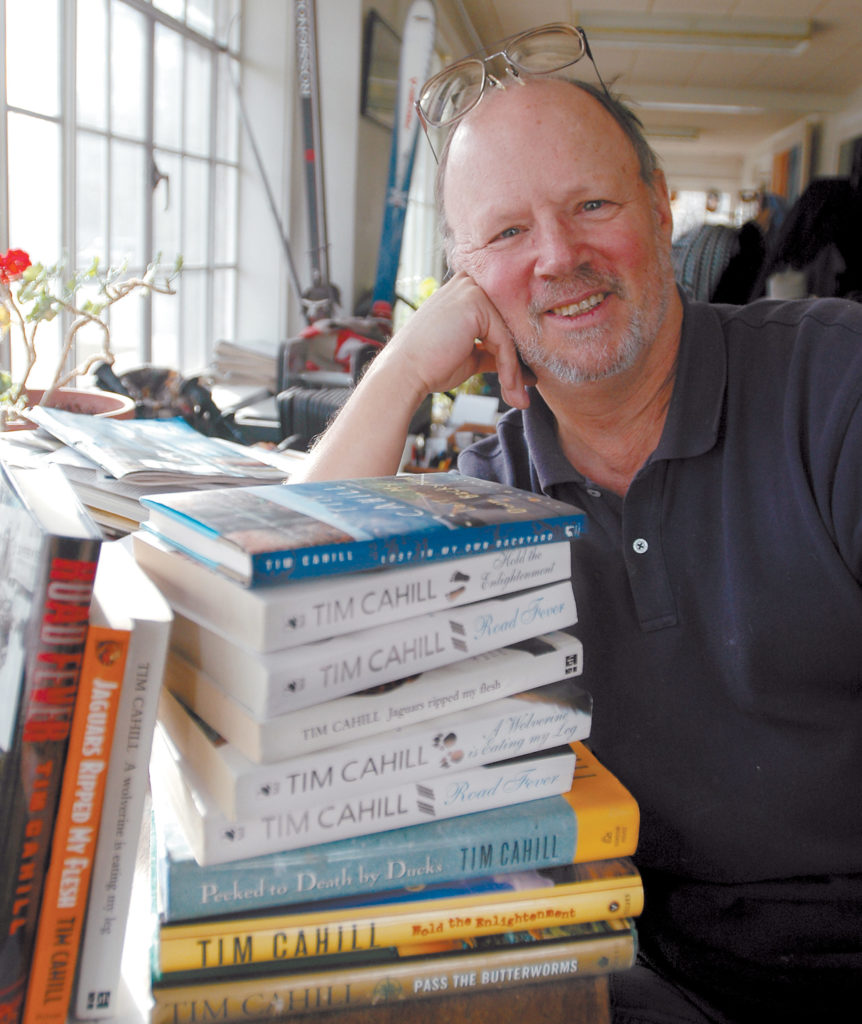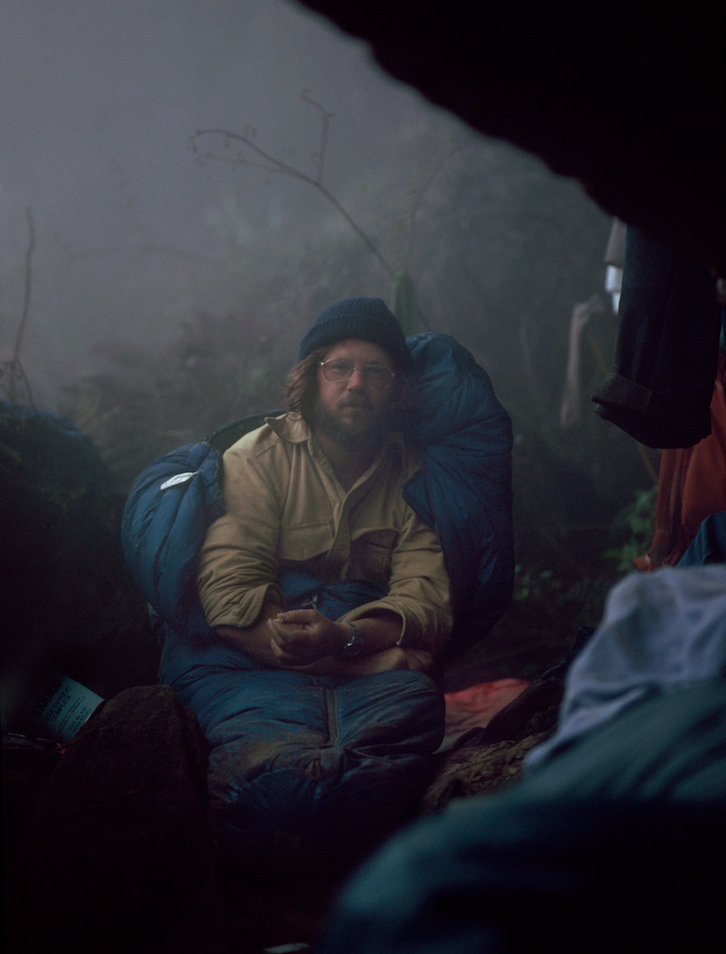
19 Aug In Conversation with Tim Cahill
For decades, Tim Cahill has delighted and thrilled readers by journeying wholeheartedly to far-flung destinations in pursuit of a story. Hundreds of magazine articles and ten books later, the adventure travel writer and founding editor of Outside magazine joins Sabine Bergmann in conversation. The pair discusses how preparedness, curiosity and a team of allies can help in almost any situation — whether it’s flying into the eye of a hurricane, searching for an extinct tiger in the midst of an insurrection, or preserving the wilderness at large:
SB: You’re known for venturing into hair-raising situations. You’ve written books with titles like Jaguars Ripped My Flesh, A Wolverine is Eating My Leg, and Pecked to Death by Ducks. So, let’s talk about danger. Do you believe that true adventure requires a little bit of danger?
TC: Yeah, but the things I’ve done that people conceive to be dangerous are things that I trained for. Some things were on the edge. But I trained.
SB: But you go into situations that would make many people nervous, like going into the eye of a hurricane. You go into places where, even though you are prepared, anything could happen.
TC: Well, the guys who fly into the eye of a hurricane, you know, they’re in the service. They do it for a living. The hard part about that is convincing them that they ought to let you on the plane!
SB: Is there a thrill to being in those kinds of situations?
TC: There’s a certain thrill. In the early part of my career, I did a lot of things just because there was risk involved — skydiving, repelling off of El Capitan. That was just risk for risk’s sake. But I exhausted my curiosity on risk.
SB: Adventure travel and risk often get conflated. People say, “If I’m going to go and have an incredible experience, I have to do something where I might not come back.”
TC: You can have an experience and still be prepared. If you’re going to be walking across the Sahara Desert, you should be in good walking shape by the time you get there.
SB: Generally. But you are out of your element to a certain extent. When I was dreaming of being a travel writer, the places I wanted to go to were places where I’m totally out of my element. Those are the places that call to me. That’s part of what makes a good story: going in with different eyes.
TC: Exactly. I was fascinated by childhood stories about Tarzan. Okay, I realized Edgar Rice Burroughs had never been to Africa, but somehow the Congo called to me. I wanted to walk into the jungle. It’s something that I thought about for a long time.
SB: I think that’s more interesting than pursuing risk for risk’s sake.
TC: It is. Absolutely. As it turned out, I walked into many jungles — forests in Africa, a lot of the Amazon — and I came to the conclusion that I would just as soon not be in a jungle.
SB: It took you walking across all of those places to figure that out?
TC: Yep! (Laughs.) You know, if I’m gonna go somewhere, I want mountains, arid plains, deserts — that’s my kind of thing. I’ll pick where I go now.
SB: You’re semi-retired, so you do get to pick where you go. Are you going to places that are arid and mountainous?
TC: You know what I’m going to do? I’m going to take one of those river tours through Eastern Europe and go to a whole bunch of cities I’ve never been to, and go to restaurants! I’ve always been out with a backpack, cooking my own meals. The part of my travel portfolio that’s unfilled is a weekend in Paris at a nice restaurant.
SB: That’s what’s become exotic to you!
(Both laugh.)
TC: It is!
SB: You know that people at these Parisian restaurants are dreaming of their adventures walking through the Amazon!
TC: I was very lucky in my life that I could go do pretty much what I wanted to do, and get paid for it. And I still live in Montana; I still walk in the mountains just about every day; I still row the river.
SB: But some nice meals in some European cities sounds pretty good.
TC: It sounds pretty good to me!
SB: It seems that curiosity really drives you.
TC: It’s the schoolteacher mentality. I think most writers have it. You go to some place and you learn something that fascinates you and you just want to tell other people about it. That’s part of the joy of writing the story.
When I’m in a culture that’s quite foreign to me, one of the things I always ask is, “What’s your creation myth? How did you guys get to be here?” I just love to hear everybody’s creation story.
SB: What were some of the earlier experiences in your life that led you to do this?
TC: I remember being a ten- and eleven-year-old kid, living in Wisconsin and telling my father, “Well, my friends got to go to Florida with their parents. We never go anywhere!”
Dad said, “Well, the YMCA has a swimming team. If you make the team, you’ll get to travel.”
SB: So that was something you were seeking out from a young age, to be able to travel?
TC: I think so. The first plane ride I ever took was for a swimming meet for the University of Wisconsin with Minnesota. So I associate physical work with travel. I like travel, but the old athlete in me says, “Okay, but you have to earn it.” I guess I earned it by writing about it.
SB: Yeah. As a writer, you’re not just going to a destination—
TC: You’ve got to find the story.
SB: You’ve got to find the story.
TC: And write the story! For a while I was traveling like a historical monkey. I would be on a boat on my way to Antarctica, finishing my story about Tonga while bashing through 70-ft waves.
SB: You have to be motivated.
TC: I was obsessed.
SB: What does that look like?
TC: Around 2001, there was a paragraph article in the London Sunday Express that said, “Turkish farmers are beginning to see the Caspian tiger. It’s supposedly, since 1976, never been seen, and yet people are reporting seeing it.”
So, I went to the editor of Men’s Journal and said, “I want to go to Turkey. I want to find the extinct Caspian tiger.” I knew that even if I didn’t find the damn tiger, it’s still a good story. Failure is as good a story as success. Within a week, I was on a plane, on my way to Turkey. I had one paragraph to go from.
SB: Did you arrive with a plan?
TC: We had to let circumstances guide us.
I was with my friend Thomas, who was a fluent Turkish speaker. We went to the Turkish equivalent of federal wildlife management and said, “We’re looking for a tiger; we hear it’s in the southeast.”
The guy said, “I’ve never been to the southeast. You can’t go to the southeast. We’ve got the PKK, the Kurds, an insurrection across the border. I feel bad that you guys are going.”
So we said, “Come along!” Now we had an official with us.
Because of the PKK insurrection, there were all kinds of roadblocks and guys with guns. They would look at my passport and Tommy would say, “You know Tim, your last name in Turkish is pronounced Djaheel. It means ignorant. But Tim is like Timur, a pretty good Turkish name!”
It’s like being called Attila the Dope. The guards would get a big laugh out of that. The federal official would say, “These guys are okay!”
And we went to various places, and they kept pointing us further and further into the war zone.
SB: Were you scared to go into a war zone?
TC: No. No, no, no! We were looking for the tiger! We were out of the loop. Who was gonna shoot us?
We got down there, and we pulled into this little town called Shemdinli — which had had some terrorist action just the week before — and then two detectives came over, guys in black pants, and black leather coats. They said: “You have to go to the police station.”
When we got to the police station, my friend Tommy banged through the chief of police’s door and said, “What is the meaning of this?” in Turkish. But it turned out the police chief spoke English. He was a peace keeper in Bosnia. Hey, guess what? The sheriff of Livingston, Montana was a peace keeper in Bosnia!
“Sir, did you know Charlie Johnson?”
“Yep!”
Now we had the police chief on our side.
SB: You’re building your team.
TC: We’re building our team!
I did get to the place where the tiger had been sighted, but it was with several armored personnel carriers: not the ideal way to search for a reclusive tiger. But we talked to some of the villagers and I had pictures of various tigers and I’d say, “Which one did you see? This one? That one?”
They had seen it. The tiger was there.
This is the interesting part: Nobody could go out into that forest because it was mined. If you were out there, just in a group of one or two, you could’ve been shot by a soldier who thought you were a PKK terrorist or PKK terrorists who thought you were a soldier. So the wolves came back; the pigs came back; maybe the tiger came back! That’s the irony: War is good for creatures.
SB: Places where humans don’t go can be good for creatures. But sometimes the opposite is true.
TC: You know, some of the very early stories I did in South America are now commercial tours. If you have a desire to preserve the wilderness, and preserve a place in particular, the main vector of how you’re going to do that is the amount of people who have been there — the people who have walked the trail, climbed the mountain, descended the river. Those people are invested in that place.
So, when the place becomes threatened by logging, petrochemical companies, what have you, you don’t have to educate everybody on earth as to what this place is. Lots of people know about it. Lots of people are personally invested in the wildness of the place, and find a certain sacredness in it.
SB: So it’s not just about building a team in travel, but about joining a larger one.
TC: Yeah, exactly. And I don’t care if you go into the Amazon on your own with a backpack, or if you go with a tour company. Either way, you become invested in the place.
SB: Maybe the greatest risk is in not going?
TC: Maybe it is.
To read more about Tim Cahill’s adventures, check out his upcoming feature in the October issue of Outside, where he discusses all that led to his brief death in the Grand Canyon.
Latest posts by Sabine Bergmann (see all)
- The Unfolding Perspective of Travel - November 25, 2017
- The Call of Autumn Colors: Fall Foliage Photo Poetry - October 25, 2017
- In Conversation with Tim Cahill - August 19, 2017






No Comments